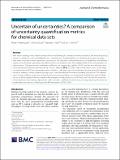Uncertain of uncertainties? A comparison of uncertainty quantification metrics for chemical data sets
Author(s)
Rasmussen, Maria H.; Duan, Chenru; Kulik, Heather J.; Jensen, Jan H.
Download13321_2023_Article_790.pdf (2.378Mb)
Publisher with Creative Commons License
Publisher with Creative Commons License
Creative Commons Attribution
Terms of use
Metadata
Show full item recordAbstract
With the increasingly more important role of machine learning (ML) models in chemical research, the need for putting a level of confidence to the model predictions naturally arises. Several methods for obtaining uncertainty estimates have been proposed in recent years but consensus on the evaluation of these have yet to be established and different studies on uncertainties generally uses different metrics to evaluate them. We compare three of the most popular validation metrics (Spearman’s rank correlation coefficient, the negative log likelihood (NLL) and the miscalibration area) to the error-based calibration introduced by Levi et al. (Sensors 2022, 22, 5540). Importantly, metrics such as the negative log likelihood (NLL) and Spearman’s rank correlation coefficient bear little information in themselves. We therefore introduce reference values obtained through errors simulated directly from the uncertainty distribution. The different metrics target different properties and we show how to interpret them, but we generally find the best overall validation to be done based on the error-based calibration plot introduced by Levi et al. Finally, we illustrate the sensitivity of ranking-based methods (e.g. Spearman’s rank correlation coefficient) towards test set design by using the same toy model ferent test sets and obtaining vastly different metrics (0.05 vs. 0.65).
Date issued
2023-12-18Department
Massachusetts Institute of Technology. Department of Chemistry; Massachusetts Institute of Technology. Department of Chemical EngineeringPublisher
Springer International Publishing
Citation
Journal of Cheminformatics. 2023 Dec 18;15(1):121
Version: Final published version